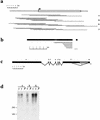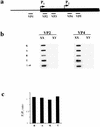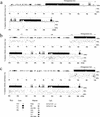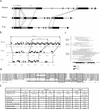Characterization of the genomic Xist locus in rodents reveals conservation of overall gene structure and tandem repeats but rapid evolution of unique sequence
- PMID: 11337478
- PMCID: PMC311126
- DOI: 10.1101/gr.174901
Characterization of the genomic Xist locus in rodents reveals conservation of overall gene structure and tandem repeats but rapid evolution of unique sequence
Abstract
The Xist locus plays a central role in the regulation of X chromosome inactivation in mammals, although its exact mode of action remains to be elucidated. Evolutionary studies are important in identifying conserved genomic regions and defining their possible function. Here we report cloning, sequence analysis, and detailed characterization of the Xist gene from four closely related species of common vole (field mouse), Microtus arvalis. Our analysis reveals that there is overall conservation of Xist gene structure both between different vole species and relative to mouse and human Xist/XIST. Within transcribed sequence, there is significant conservation over five short regions of unique sequence and also over Xist-specific tandem repeats. The majority of unique sequences, however, are evolving at an unexpectedly high rate. This is also evident from analysis of flanking sequences, which reveals a very high rate of rearrangement and invasion of dispersed repeats. We discuss these results in the context of Xist gene function and evolution.
Figures








Similar articles
-
A regulatory potential of the Xist gene promoter in vole M. rossiaemeridionalis.PLoS One. 2012;7(5):e33994. doi: 10.1371/journal.pone.0033994. Epub 2012 May 11. PLoS One. 2012. PMID: 22606223 Free PMC article.
-
Comparative mapping of X chromosomes in vole species of the genus Microtus.Chromosome Res. 1998 Jan;6(1):41-8. doi: 10.1023/a:1009266324602. Chromosome Res. 1998. PMID: 9510509
-
A revision of the human XIST gene organization and structural comparison with mouse Xist.Mamm Genome. 2000 Mar;11(3):220-4. doi: 10.1007/s003350010040. Mamm Genome. 2000. PMID: 10723727
-
Xist regulation and function explored.Hum Genet. 2011 Aug;130(2):223-36. doi: 10.1007/s00439-011-1008-7. Epub 2011 May 28. Hum Genet. 2011. PMID: 21626138 Free PMC article. Review.
-
Xist and X chromosome inactivation.Mol Cell Endocrinol. 1998 May 25;140(1-2):71-6. doi: 10.1016/s0303-7207(98)00032-x. Mol Cell Endocrinol. 1998. PMID: 9722171 Review.
Cited by
-
Mapping of Replication Origins in the X Inactivation Center of Vole Microtus levis Reveals Extended Replication Initiation Zone.PLoS One. 2015 Jun 3;10(6):e0128497. doi: 10.1371/journal.pone.0128497. eCollection 2015. PLoS One. 2015. PMID: 26038842 Free PMC article.
-
Identification of TSIX, encoding an RNA antisense to human XIST, reveals differences from its murine counterpart: implications for X inactivation.Am J Hum Genet. 2001 Nov;69(5):951-60. doi: 10.1086/324022. Epub 2001 Sep 12. Am J Hum Genet. 2001. PMID: 11555794 Free PMC article.
-
Long noncoding RNA ENST00000436340 promotes podocyte injury in diabetic kidney disease by facilitating the association of PTBP1 with RAB3B.Cell Death Dis. 2023 Feb 15;14(2):130. doi: 10.1038/s41419-023-05658-7. Cell Death Dis. 2023. PMID: 36792603 Free PMC article.
-
Nonlinear sequence similarity between the Xist and Rsx long noncoding RNAs suggests shared functions of tandem repeat domains.RNA. 2019 Aug;25(8):1004-1019. doi: 10.1261/rna.069815.118. Epub 2019 May 16. RNA. 2019. PMID: 31097619 Free PMC article.
-
Long Intergenic Non-Coding RNAs: Novel Drivers of Human Lymphocyte Differentiation.Front Immunol. 2015 Apr 15;6:175. doi: 10.3389/fimmu.2015.00175. eCollection 2015. Front Immunol. 2015. PMID: 25926836 Free PMC article. Review.
References
-
- Altschul SF, Gish W, Miller W, Myers EW, Lipman DJ. Basic local alignment search tool. J Mol Biol. 1990;215:403–410. - PubMed
-
- Bird AP. CpG rich islands and the function of DNA methylation. Nature. 1986;321:209–213. - PubMed
-
- Borsani G, Tonlorenzi R, Simmler MC, Dandolo L, Arnaud D, Capra V, Grompe M, Pizzuti A, Muzny D, Lawrence C, et al. Characterization of a murine gene expressed from the inactive X chromosome. Nature. 1991;351:325–329. - PubMed
Publication types
MeSH terms
Substances
Associated data
- Actions
- Actions
- Actions
- Actions
- Actions
Grants and funding
LinkOut - more resources
Full Text Sources
Other Literature Sources
Medical
